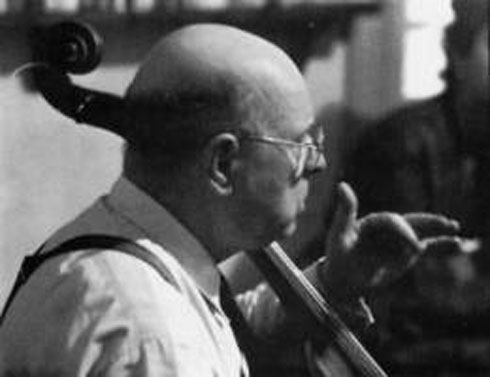The background of an idea
Pablo Casals is said to have dreamt of an orchestra consisting exclusively of cellos - an unusual idea, but not an entirely novel one. In fact, it is evidence of his strong historical memory. For during the era of what we now refer to as "Early Music", that is to say, three or four hundred years ago, there were the so-called "consorts of gambas", small ensembles consisting of only that tender-sounding cousin of the violoncello, namely the viola da gamba, the viol that is positioned between the legs while being played, rather than held in the arms. Well and good: but these many-stringed instruments, with their nasal tone-quality and fretted finger-boards were constructed in various sizes and diverse registers. A gamba consort thus included higher and deeper instrumental groups, and this distinguishes them from the pure cello ensemble. But its tone-color was, in its basic character, similarly uniform. Pablo Casals undertook several initiatives in order to see to it that his dream of a pure "knee-viol" ensemble would be realized.
The great Spanish cellist knew his instrument and its possibilities with precision, and certainly understood that a mono-instrumental orchestra could be successful only with a group of deeper strings. Serious competition in this area is hardly a danger. Just imagine a stage full of violinists, with no other instruments whatever. The musicians would have much to offer: their violins might be jubilant and sparkling, and they might well propel their virtuosity in the higher register all the way to the limits of the perceptible, or soothe it into a tender web of sound - they might even charm a true kaleidoscope of sound-images from their devil's instrument by plucking, knocking, tapping, muting, and forcing. But sooner or later, the listener would come to miss the fundament, and this display would thus only have succeeded in intensifying a desire for the musical capacities of the deeper voices. And even the violas cannot fulfill this desire. That leaves only the contrabasses, but in their high range, they lack the necessary penetrating power, that little pinch of mordancy always possessed by the cellos, even when they approach the tonal areas of the flutes and violins. Our everyday speech has thus far only discovered the sharper, higher, and louder instruments for its image-world. Heaven may be "hung with violins", as the saying goes, yet this operetta-like celestial experience was conceived for people who have both feet on the firm ground of reality.

It is the cello itself, however, that is responsible for the "grounding" of musical enjoyment, for it even stands with three feet on solid earth: one of its own, and the two human ones supporting it. No doubt about it: the cello really represents the universal among the instruments of the orchestra. It is at home in all areas of the wide tonal, audible spectrum, from the sonorous depths to the shrill heights. Its cantilena is distinguished by its unique charm, and when it is set against the full orchestra, one is always witness to a special phenomenon. In the drama of a musical score, the cellos often fix the exclamation point. From the most beautiful tone to the most muffled stroke, from the noblest singing all the way to the most irritating haze of noise: for them, everything is possible, and their well-formed bodies always provide excellent resonance for a wide diversity of musical effects. Pablo Casals was perfectly conscious of the cello's hidden talents. He promoted the instrument with his own composition - appropriately, a dance piece - his 'Sardana' whose homeland is Catalonia. He scored it for an orchestra of cellos consisting of at least 32 members. That was in 1927.




